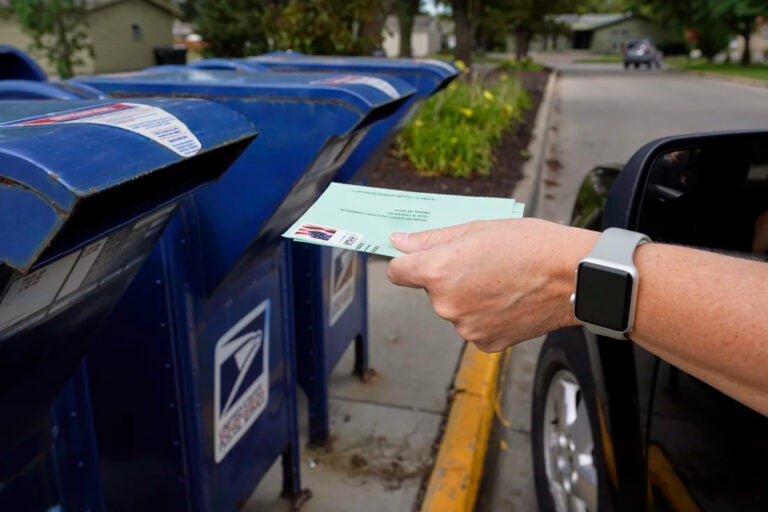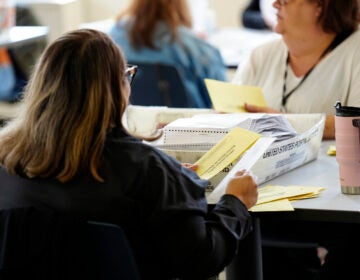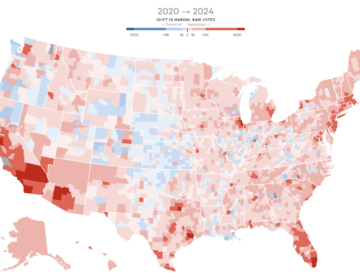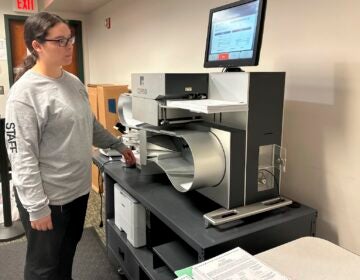U.S. voters advised to return ballots early because of mail delay concerns
Election officials around the country are raising concerns about whether the U.S. Postal Service can handle the influx of election mail expected this fall.

A person drops applications for mail-in-ballots into a mailbox in 2020 in Omaha, (Neb. Nati Harnik/AP)
This June, the final count in Utah’s Iron County left Jon Whittaker feeling ill.
Whittaker, a county clerk who runs elections in the southwestern Utah county, received more than 400 mail-in ballots for the primary that were postmarked after the state’s legal deadline of June 24. Those votes had to be left out of the official tally of results.
“It was several times more than what we are used to seeing,” Whittaker says. “Because that canvass of the will of the people is a sacred thing, it made me sick.”
The U.S. Postal Service says a number of those ballots were deposited in collection boxes too late to make the postmark deadline.
But Whittaker says he suspects the fault may not lie with all of those voters, as mishandled mail-in ballots and delayed deliveries plagued other primary elections in multiple states this year. And now, as early voting for the general elections begins, election officials around the country are raising concerns about whether the U.S. Postal Service can handle the influx of election mail expected this fall.
Last week, the National Association of State Election Directors and National Association of Secretaries of State issued a public letter to Postmaster General Louis DeJoy that echoed a recent critical report by the Postal Service’s internal watchdog, the USPS Office of Inspector General.
“We saw things that we weren’t used to seeing in this primary cycle, and it felt like it was different,” says Mandy Vigil, New Mexico’s election director and the current president of NASED. “We’ve been raising these alarms [with the Postal Service] for the past year, but the lack of response and really being able to see any true change throughout that primary cycle made us feel like this was necessary, going public.”
While the Postal Service says it is working on improvements and committed to making timely deliveries, it is also recommending mail-in voters take what DeJoy has called “a common-sense measure” — return their paper voter registration forms, absentee ballot applications and completed ballots at least one week before their states’ respective deadlines.
“Let me be clear,” DeJoy said Thursday during a press briefing. “The Postal Service is ready to deliver the nation’s mail-in ballots.”
DeJoy, who was appointed to his role in 2020, during the height of the COVID-19 pandemic, pointed to the Postal Service’s performance during that contentious general election as proof.
“In a highly sensationalized environment and during a global pandemic, we were successful in 2020, delivering a historic volume of mail-in ballots. In the 2020 general election, we delivered 99.89% of ballots from voters to election officials within seven days,” DeJoy said. “We will be even better prepared for 2024 and will perform admirably again, as we always have.”
Why election officials and the USPS’ internal watchdog are concerned
The USPS inspector general’s office audited mail operations in 13 states and Puerto Rico during this year’s primary elections and found high on-time processing scores of more than 97% for election and political mail from December 2023 through March of this year.
But the internal watchdog’s July report says it also found Postal Service workers not always following the proper procedures for handling election mail, and spotted mailed ballots missing postmarks, which many state laws require for ballots to be counted and have become increasingly relevant as more voters cast their ballots by mail.
Individual ballots are at risk of not getting counted, the report warned, because of some existing USPS policies for processing mail, as well as operational changes related to the Postal Service’s controversial “Delivering for America” reorganization plan for addressing its financial woes.
The election officials’ letter highlighted similar concerns, noting that the USPS is marking election mail sent to voters as undeliverable at “higher than usual rates, even in cases where a voter is known not to have moved” — a decision that could disenfranchise eligible voters by depriving them of mail-in ballots and lead to the cancellation of eligible voters’ registration.
In some places, the letter adds, ballots that did make it through the mail delivery system arrived at election offices 10 or more days after the postmark date.
“It’s not these one-off instances that we are able to resolve at a lower level,” Vigil at NASED says. “The concern really has been the fact that we’re seeing a systemic issue, patterns that require the higher-ups to really take notice and make a change.”
DeJoy and other USPS leaders met with a group of election officials Wednesday after he said in a letter that the Postal Service is working on promptly addressing these issues. For example, USPS says it recently transitioned to web-based training that allows managers to confirm that all employees have received the required training and is making sure their facilities post work instructions.
Starting Oct. 21, about two weeks before Election Day, USPS is set to use what it calls the “extraordinary measures” policy that it usually deploys during general elections.
“These are designed to rescue ballots that are entered in our system likely or definitely too late to make election deadlines set by election officials,” DeJoy explained during Thursday’s press briefing. “We engage in heroic efforts intended to beat the clock. These efforts are designed to be used only when the risk of deviating from our standard processes is necessary to compensate for the ballot being mailed so close to a state’s deadline.”
That policy also includes specific instructions for Postal Service employees to place postmarks on mail-in ballots. “We try to postmark every piece of mail. Sometimes it just doesn’t happen,” Adrienne Marshall, director of election and government mail services, said last month during a press briefing, adding that voters can stop by a post office in person if they want to make sure their mail-in ballot gets a postmark.
Still, many election officials suspect there are structural issues in the Postal Service’s system that are driving ballot delivery issues.

Get daily updates from WHYY News!
WHYY is your source for fact-based, in-depth journalism and information. As a nonprofit organization, we rely on financial support from readers like you. Please give today.





